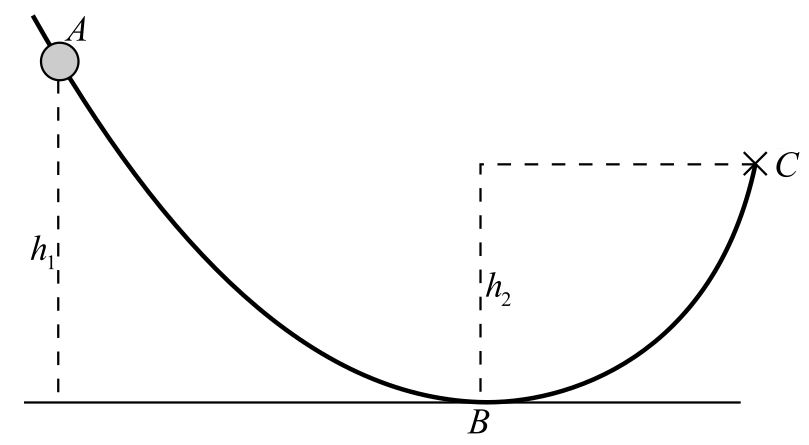
In Fig. 6-8, h1 = 200 cm, h2 = 150 cm, and at A the 3.00-g bead has a downward speed along the wire of 800 cm/s. (a) How fast is the bead moving as it passes point-B if friction is negligible? (b) How much energy did the bead lose to friction work if it rises to a height of 20.0 cm above C after it leaves the wire?
(a)
The speed of the bead at point B if it moves at a downward velocity of
Answer to Problem 51SP
Solution:
Explanation of Solution
Given data:
The speed at point A is
The height
The height
Formula used:
The expression for change in kinetic energy is written as,
Here,
The expression for change in potential energy is written as,
Here,
Explanation:
Consider the diagram.

Write the expression for the law of the conservation of energy.
Substitute
Here,
Substitute
Conclusion:
The speed of the bead at point B is
(b)
The energy lost due to friction workif the bead rises
Answer to Problem 51SP
Solution:
Explanation of Solution
Given data:
The speed at point A is
The height
The height
The mass of the bead is
Formula used:
The expression for change in kinetic energy is written as,
Here,
The expression for change in potential energy is written as,
Here,
The expression for the law of the conservation of energy is written as,
Here,
Explanation:
Considered the provided diagram.

The total height covered by the bead is
Here,
Substitute
Understand that the loss of energy is converted into the work. Therefore, the mathematical expression for the same is as follows:
Substitute
Substitute
Here, the negative sign denotes that the energy is being lost due to frictional work. Therefore,
Conclusion:
The energy lost due to friction work is
Want to see more full solutions like this?
Chapter 6 Solutions
Schaum's Outline of College Physics, Twelfth Edition (Schaum's Outlines)
- In the movie Fast X, a 10100 kg round bomb is set rolling in Rome. The bomb gets up to 17.6 m/s. To try to stop the bomb, the protagonist Dom swings the counterweight of a crane, which has a mass of 354000 kg into the bomb at 3.61 m/s in the opposite direction. Directly after the collision the crane counterweight continues in the same direction it was going at 2.13 m/s. What is the velocity (magnitude and direction) of the bomb right after the collision?arrow_forwardDon't use aiarrow_forwardMake sure to draw a sketch with scale pleasearrow_forward
- Make sure to draw a sketch with scalearrow_forwardUltimate Byleth and Little Mac fight. Little Mac, who is a boxer, dashes forward at 26.6 m/s, fist first. Byleth moves in the opposite direction at 3.79 m/s, where they collide with Little Mac’s fist. After the punch Byleth flies backwards at 11.1 m/s. How fast, and in what direction, is Little Mac now moving? Little Mac has a mass of 48.5 kg and Byleth has a mass of 72.0 kg.arrow_forwardMake sure to draw a sketch with scale as wellarrow_forward
- Make sure to draw a sketch with scale pleasearrow_forwardKirby jumps towards his enemy/ally, Meta Knight, at 2.06 m/s while Meta Knight glides in the opposite direction (toward Kirby) at 5.06 m/s. Kirby then begins to inhale, swallowing Meta Knight. What is Kirby/Meta Knight’s velocity immediately after being swallowed? Please put the magnitude of the velocity and then mark direction using dropdown menu. Kirby has a mass of 0.283 kg and Meta Knight has a mass of 0.538 kg.arrow_forwardNo Aiarrow_forward
 University Physics Volume 1PhysicsISBN:9781938168277Author:William Moebs, Samuel J. Ling, Jeff SannyPublisher:OpenStax - Rice University
University Physics Volume 1PhysicsISBN:9781938168277Author:William Moebs, Samuel J. Ling, Jeff SannyPublisher:OpenStax - Rice University Principles of Physics: A Calculus-Based TextPhysicsISBN:9781133104261Author:Raymond A. Serway, John W. JewettPublisher:Cengage Learning
Principles of Physics: A Calculus-Based TextPhysicsISBN:9781133104261Author:Raymond A. Serway, John W. JewettPublisher:Cengage Learning Physics for Scientists and Engineers, Technology ...PhysicsISBN:9781305116399Author:Raymond A. Serway, John W. JewettPublisher:Cengage Learning
Physics for Scientists and Engineers, Technology ...PhysicsISBN:9781305116399Author:Raymond A. Serway, John W. JewettPublisher:Cengage Learning Glencoe Physics: Principles and Problems, Student...PhysicsISBN:9780078807213Author:Paul W. ZitzewitzPublisher:Glencoe/McGraw-Hill
Glencoe Physics: Principles and Problems, Student...PhysicsISBN:9780078807213Author:Paul W. ZitzewitzPublisher:Glencoe/McGraw-Hill Physics for Scientists and Engineers: Foundations...PhysicsISBN:9781133939146Author:Katz, Debora M.Publisher:Cengage Learning
Physics for Scientists and Engineers: Foundations...PhysicsISBN:9781133939146Author:Katz, Debora M.Publisher:Cengage Learning College PhysicsPhysicsISBN:9781285737027Author:Raymond A. Serway, Chris VuillePublisher:Cengage Learning
College PhysicsPhysicsISBN:9781285737027Author:Raymond A. Serway, Chris VuillePublisher:Cengage Learning





